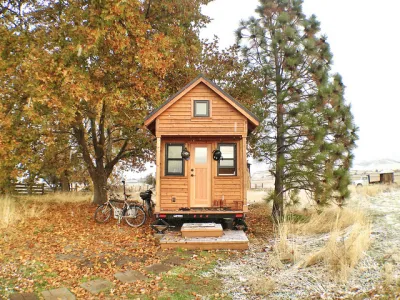People living in tiny homes drastically reduce their ecological footprints and make more sustainable lifestyle choices, research shows.

Maria Saxton reports on her dissertation research about the environmental impacts of people downsizing to tiny houses. She compares the ecological footprints of people before and after they moved into tiny houses by calculating the spatial area needed to support their needs for a year. "I found that among 80 tiny home downsizers located across the United States, ecological footprints were reduced by about 45 percent on average," says Saxton.
In addition, she finds that people’s behaviors became more sustainable in a number of ways after moving into tiny homes:
As a whole, I found that after downsizing people were more likely to eat less energy-intensive food products and adopt more environmentally conscious eating habits, such as eating more locally and growing more of their own food. Participants traveled less by car, motorcycle, bus, train and airplane, and drove more fuel-efficient cars than they did before downsizing.
Based on her survey and interview findings, Saxton also estimates that 366 million acres of resources could be saved if 10 percent of the population downsized to tiny homes. She hopes that this evidence will help support local rezoning efforts to allow tiny homes and the development of sustainable housing.
FULL STORY: When People Move Into Tiny Homes, They Adopt Greener Lifestyles

National Parks Layoffs Will Cause Communities to Lose Billions
Thousands of essential park workers were laid off this week, just before the busy spring break season.

Retro-silient?: America’s First “Eco-burb,” The Woodlands Turns 50
A master-planned community north of Houston offers lessons on green infrastructure and resilient design, but falls short of its founder’s lofty affordability and walkability goals.

Delivering for America Plan Will Downgrade Mail Service in at Least 49.5 Percent of Zip Codes
Republican and Democrat lawmakers criticize the plan for its disproportionate negative impact on rural communities.

Test News Post 1
This is a summary

Test News Headline 46
Test for the image on the front page.

Balancing Bombs and Butterflies: How the National Guard Protects a Rare Species
The National Guard at Fort Indiantown Gap uses GIS technology and land management strategies to balance military training with conservation efforts, ensuring the survival of the rare eastern regal fritillary butterfly.
Urban Design for Planners 1: Software Tools
This six-course series explores essential urban design concepts using open source software and equips planners with the tools they need to participate fully in the urban design process.
Planning for Universal Design
Learn the tools for implementing Universal Design in planning regulations.
EMC Planning Group, Inc.
Planetizen
Planetizen
Mpact (formerly Rail~Volution)
Great Falls Development Authority, Inc.
HUDs Office of Policy Development and Research
NYU Wagner Graduate School of Public Service


























